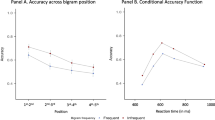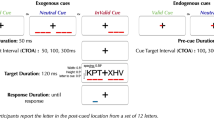Abstract
Linguistic research suggests that certain skeletal frames (e.g., CVC) are preferred to others (e.g., VCC). We examine whether such preferences constrain reading in the Stroop task. We demonstrate that CCVC nonwords facilitate naming the color black (\({{\rm /bl{\ae}k}}\)/, a CCVC frame) relative to CVC controls. Conversely, CCVC items inhibit red (a CVC frame) relative to CVC controls. These results suggest that readers are sensitive to the congruency between the skeletal structure of color names and printed nonwords. However, various frames are not all equally preferred: the color black is named faster with a VCC frame, an infrequent and ill-formed frame, relative to a CVC frame, a frequent and grammatically preferred frame. These findings suggest that the representation of printed words specifies distinct slots for consonants and vowels, and readers are equipped with preferences (either grammatical or statistical) concerning skeletal frames. These conclusions underscore the contribution of linguistic knowledge to skilled reading.
Similar content being viewed by others
References
Abramson M., Goldinger S. D. (1997) What the reader’s eye tells the mind’s ear: Silent reading activates inner speech. Perception and Psychophysics 59: 1059–1068
Berent I. (1997) Phonological priming in the lexical decision task: Regularity effects are not necessary evidence for assembly. Journal of Experimental Psychology: Human Perception and Performance 23: 1727–1742
Berent I., Bouissa R., Tuller B. (2001) The effect of shared structure and content on reading nonwords: Evidence for a CV skeleton. Journal of Experimental Psychology: Learning, Memory, and Cognition 27: 1042–1057
Berent I., Lennertz T., Jun J., Moreno M. A., Smolensky P. (2008) Language universals in human brains. Proceedings of the National Academy of Sciences 105: 5321–5325
Berent I., Marom M. (2005) The skeletal structure of printed words: Evidence from the Stroop task. Journal of Experimental Psychology: Human Perception & Performance 31: 328–338
Berent I., Steriade D., Lennertz T., Vaknin V. (2007) What we know about what we have never heard: Evidence from perceptual illusions. Cognition 104: 591–630
Berent I., Tzelgov J., Bibi U. (2006) The autonomous computation of morphophonological structure in reading: Evidence from the Stroop task. The Mental Lexicon 1(2): 201–230
Besner D. (2001) The myth of ballistic processing: Evidence from the Stroop’s paradigm. Psychonomic Bulletin and Review 8: 324–330
Bibi U., Tzelgov J., Henik A. (2000) Stroop effect in words that differ from color words in one letter only. Psychonomic Bulletin & Review 7: 678–683
Boudelaa S., Marslen-Wilson W. D. (2004) Abstract morphemes and lexical representation: The CV-Skeleton in Arabic. Cognition 92: 271–303
Caramazza A., Miceli G. (1993) The structure of graphemic representations. Cognition 37: 243–297
Costa A., Sebastian-Gallés N. (1998) Abstract structure in language production: Evidence from Spanish. Journal of Experimental Psychology: Learning, Memory, and Cognition 24: 886–903
Crump M. J., Gong Z., Milliken B. (2006) The context-specific proportion congruent stroop effect: Location as a contextual cue. Psychonomic Bulletin & Review 13: 316–321
Ferrand L., Segui J. (1998) The syllable’s role in speech production: Are syllables chunks, schemas, or both? Psychonomic Bulletin & Review 5: 253–258
Fromkin V. (1973) Speech errors as linguistic evidence. The Hague, Mouton
Greenberg J. H. (1978) Some generalizations concerning initial and final consonant clusters. In: Greenberg J. H., Ferguson C. A., Moravcsik E. A. (eds) Universals of Human Language (Vol. 2). Stanford University Press, Stanford, pp 243–279
Kello C. T., Plaut D. C., MacWhinney B. (2000) The task dependence of staged versus cascaded processing: An empirical and computational study of Stroop interference in speech production. Journal of Experimental Psychology: General 129: 340–360
Kenstowicz M. (1994) Phonology in generative grammar. Blackwell, Cambridge, MA
Kucera H., Francis W. (1967) Computational analysis of present-day American English. Brown University Press, Providence, RI
Levin, J. (1985). A metrical theory of syllabicity. Doctoral Dissertation, MIT.
Lukatela G., Eaton T., Turvey M. T. (2001) Does visual word identification involve a sub-phonemic level? Cognition 78: B41–B52
MacNeilage P. F. (1998) The frame/content theory of evolution of speech production. Behavioral and Brain Sciences 21: 499–511
McCarthy J. (1981) A prosodic theory of nonconcatenative morphology. Linguistic Inquiry 12: 373–418
McCarthy J., Prince A. (1995) Prosodic morphology. In: Goldsmith J. A. (eds) Phonological theory. Basil Blackwell, Oxford, pp 318–366
Meijer P. (1996) Suprasegmental structures in phonological encoding: The CV structure. Journal of Memory and Language 35: 840–853
Nespor M., Peña M., Mehler J. (2003) On the different roles of vowels and consonants in speech processing and language acquisition. Lingue e Linguaggio 2: 223–229
Perfetti C. A., Bell L. (1991) Phonemic activation during the first 40 ms. of word identification. Evidence from backward masking and priming. Journal of Memory and Language 30: 473–485
Prince A., Smolensky P. (1993) Optimality theory: Constraint interaction in generative grammar. Blackwell, Malden, MA
Ramus F., Mehler J. (1999) Language identification with suprasegmental cues: A study based on speech resynthesis. The Journal of the Acoustical Society of America 105: 512–521
Ramus F., Nespor M., Mehler J. (1999) Correlates of linguistic rhythm in the speech signal. Cognition 73: 265–292
Rapp B., Caramazza A. (1997) From graphemes to abstract letter shapes: Levels of representation in written spelling. Journal of Experimental Psychology: Human Perception and Performance 23: 1130–1152
Raz A., Fan J., Posner M. I. (2005) Hypnotic suggestion reduces conflict in the human brain. Proceedings of the National Academy of Sciences, USA 102: 9978–9983
Sevald C., Dell G., Cole J. (1995) Syllable structure in speech production: Are syllables chunks or schemas? Journal of Memory & Language 34: 807–820
Stemberger J. P. (1984) Length as a suprasegmental: Evidence from speech errors. Language 60: 895–913
Stroop J. R. (1935) Studies of interference in serial verbal reactions. Journal of Experimental Psychology 18: 643–662
Taft M., Kougious P. (2004) The processing of morpheme-like units in monomorphemic words. Brain & Language 90: 9–16
Treiman R., Mullennix J., Bijeljac-Babic R., Richmond-Welty D. (1995) The special role of rimes in the description, use, and acquisition of English orthography. Journal of Experimental Psychology: General 124: 107–136
Tzelgov J., Henik A., Berger J. (1992a) Controlling Stroop effect by manipulating expectation for color related stimuli. Memory & Cognition 20: 727–735
Tzelgov J., Meyer J., Henik A. (1992b) Automatic and intentional processing of numerical information. Journal of Experimental Psychology: Learning, Memory, and Cognition 18: 166–179
Van Orden G. C. (1991) Phonological mediation is fundamental to reading. In: Besner D., Humphreys G. (eds) Basic process in reading: Visual word recognition. LEA, Hillsdale, NJ, pp 77–103
Author information
Authors and Affiliations
Corresponding author
Additional information
This research was supported by NIDCD grant R01 DC003277 to Iris Berent.
Rights and permissions
About this article
Cite this article
Marom, M., Berent, I. Phonological Constraints on the Assembly of Skeletal Structure in Reading. J Psycholinguist Res 39, 67–88 (2010). https://doi.org/10.1007/s10936-009-9126-2
Received:
Accepted:
Published:
Issue Date:
DOI: https://doi.org/10.1007/s10936-009-9126-2




